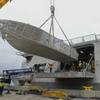Lifecycle Strategies Important for Navy
Steve Carmel, Senior Vice President, Maritime Services at Maersk Line, Limited (MLL) was a keynote speaker at the Naval Logistics Symposium on July 22. The symposium, organized by the American Society of Naval Engineers (ASNE), an organization comprising of civilian and military naval engineers, focused on the challenges of implementing effective lifecycle management of naval assets. As a member of the Chief of Naval Operations Executive Panel, Carmel is in a unique position to bridge government and commercial perspectives. Notably, Admiral Gary Roughead, Chief of Naval Operations, also spoke at the symposium.
Carmel, responsible for MLL’s technical and operating activities, highlighted the effectiveness of commercial best practices as a means to improve the utilization and extend the life of the Navy’s aging fleet. Carmel pointed out that it is imperative for operators to understand the effects of any modification to a vessel.
“We must treat the ship as a system and recognize that changes to one component will impact operating efficiency and costs elsewhere,” he said. Modifications of any extent could have adverse effects on performance and cost if individual changes are not placed in the context of the whole vessel. Carmel noted, “Optimizing individual components of a system does not always optimize the system itself, and we are mindful of that… We must treat the ship as a component in a larger system and remember the ultimate objective is to optimize the network, or larger system.”
Predictive maintenance is an important component of a lifecycle strategy, yet the ability to forecast repair requirements or failures necessitates an integrated assessment. “What we need, is a system capable of integrating data from all the various information systems to connect the seemingly unrelated events.” Information must include as many relevant factors that affect ship operations, including trim, speed, weather and sea conditions, in order to have a full view of the operating environment when a component breaks down. Even though a commercial vessel can have 10,000 sensors onboard, data systems need to integrate in order to create actionable information. Carmel recognized that the Navy and commercial operators share this problem.
Carmel emphasized the importance of understanding the costs of trade-offs. For example, innovative measures and details in design can have an overall effect with labor costs in the long term.
“When considering total cost of ownership, a significant difference between us and the military is that we impute to the vessel a cost for downtime and consider that cost in the total cost of ownership picture,” stated Carmel. He noted approaches to dry docking, supply management (procurement), and ship design that result in operational reliability of over 99% across the MLL fleet.
Many of the strategies and concerns that Carmel discussed and utilized by MLL’s Maritime Technical Services business unit were addressed in the recent Government Accountability Office (GAO) report, which reviewed key practices used by commercial shipping organizations that demonstrate adequate cost, scheduling and ship performance and the degree to which the Navy uses them. The report recognized the importance of how commercial organizations attain critical, thorough knowledge before a ship plan can be executed in order to meet budgets and time.
The missions of commercial shipping and the Navy are inevitably different, but the link for lifecycle strategies can be unified with best practices. Leveraging ideas from commercial shipping and the Navy will help optimize efforts on both ends for a sustainable fleet. Carmel closed by noting, “There are things we can learn from each other.”










